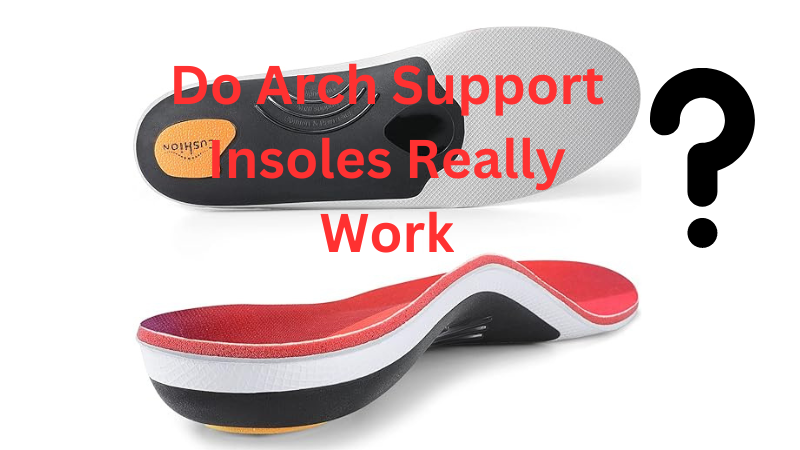Do arch support insoles work?

This is the part of one’s feet where having a proper support system is paramount. Sportsmen, working people, walking enthusiasts, and people who cannot run for miles but want to have a good walk deserve the best arch support possible. This blog post presents all the information you will ever need about arch support insole work.
Understanding Arch Support
What is Arch Support?
Arch support categorizes the insole or shoe support for the arch of the foot. Your arch is the curved area at the bottom of the foot and is crucial to walking running and standing accurately. Having good arch supports reduces pressure on certain parts of the foot by distributing weight to the whole foot muscles and joints.
Types of Arches
Every person is unique in some ways, and their feet are not an exception it is important to consider your arch type when purchasing the insoles. There are three main types of arches:
High Arches (Cavus Foot): High arches are not very common, this makes the foot roll outwards whenever one is walking. This puts so much pressure on the side of the foot and by so doing; it produces a lot of pain and discomfort.
Neutral Arches: Individuals with neutral arches have feet that provide a balanced platform. Nevertheless, a neutral position of the arch can also use proper support to avoid foot tiredness and pain.
Flat Feet (Low Arches): Sesamoid dysplasia is characterized by low or flattening of the proximal transverse arch. This results in overpronation, where the foot rolls inward to the greatest extent putting extra pressure on the inner foot, the knees as well and the lower back.
Below, it is possible to find the summary that will ease your understanding of your arch type and help to choose the right arch support insoles.
The Benefits of Arch Support Insoles
Pain Relief
One of the main causes of the use of arch support insoles is for the solace of pain. From plantar fasciitis to flat feet or just plain old foot discomfort, having the right insoles can make a big contrast. In supporting the arch, these insoles reduce pressure on a plantar fascia – a band of tissue that runs from your toes to heel – and therefore decrease inflammation and pain.
Improved Posture and Balance
Insoles created with arch support deliver more than foot protection; you get an improved posture and balance too. This way when our feet are properly supported our spines and other body structures tend to be well aligned. This can help prevent the formation of back, hip, or knee issues that result from improper foot motion or functioning.
Enhanced Athletic Performance
To athletes especially, this is good and important news since arch support is very essential. Whether you are a jogger, a jumper, or a sports person, some insoles can help to improve your performance by giving the much-needed stability and thereby minimizing injuries. Shoes with good arch support make your feet work well, and that is something that you need when you want to step on the accelerator without compromising your safety.
Reduced Fatigue
It is especially true for those people who spend a great deal of time at work standing most of the time. These insoles can help you avoid fatigue resulting from inadequate support for your feet for most of the day. It is especially useful for job positions where employees spend most of their working hours on their feet like caregivers, clerks, and educators.
Prevention of Foot Problems
It is not only those experiencing foot pain that can benefit from these insoles, they can also be part of preventive measures. With the appropriate support, they can help to avoid many foot concerns including bunions, corns, and calluses from occurring at all. This is true for people with a family history of foot problems or for those who have specific physical jobs or hobbies that stress their feet.
How to Select the Right Arch Support Insoles
Identify Your Arch Type
Anyone buying insoles should know they come in different arch types. This can easily be ascertained by performing what is referred to as the wet test on the paper. The wider part of the foot is going to show if you have high arches, normal arches, or flat feet. Once you recognize your arch type, some insoles will meet the needs of your feet so you can find the equitable one for you.
Consider Your Footwear
Various types of insoles cannot be worn with different types of shoes at all. Regarding these insoles, however, there is something you should know, namely the shoe into which you will place these insoles Most of these insoles can be used with any type of shoe. For example, if you want to order insoles for running shoes then the one that you have to view is a cushion and support. Especially if it’s about dress shoes, insoles should be as slim as it possibly can be in order not to occupy much space in the shoe.
Material Matters
He found that the type of material used for the insoles has considerable influence on the level of comfort and sturdiness of the shoe. Common materials include:
Foam: Can afford softness and firmness but can also deteriorate fast.
Gel: It provides equally good cushioning to the shocks that can be imposed on it and feels comfortable when worn.
Cork: Sturdy and offers good stability and, at the same time, maybe considered stiff.
Leather: Provides a relaxed look and feel and it is breathable but it will not have adequate cushioning.
Think about which fabric type is most suitable to your situation when it comes to insoles.
Custom vs. Over-the-Counter
It has two main categories: These comprise counter and prescription, and custom-made and off-the-counter (OTC).
Custom Insoles: These are normally prescribed by a professional in feet after probably conducting tests on your feet. They are the most accurate kind of support though they are costly.
Over-the-Counter Insoles: These are easily found and are available in different sizes and specifically different arches. They are cheaper and could serve the purpose of many individuals.
In case, you have severe foot conditions or certain requirements, the custom insoles would be a good idea to spend money. But for general support and pain issues, OTC insoles do the trick then.
Try Before You Buy
If possible, slip your feet into the insoles to get a feel of them before you buy them. Even when home take a stroll and feel the environment and learn how they would feel being in your position. The right insoles should be comfortable and supportive from the get-go and they should not be too firm or thick.
Caring for Your Arch Support Insoles
Cleaning and Maintenance
When it comes to washing most insoles, you do not need to use strong agents; use warm soapy water. Do not use acidic products or wash them because they will deteriorate the material. To minimize this, you should dry your insoles with air and ensure that you put them back in the shoes when they are drying.
Replacing Your Insoles
Arch support insoles are not permanent. You should change insoles every 6-12 months depending on usage. Replace them if you notice wear on the support or if they feel uncomfortable.
Common Misconceptions About Arch Support Insoles
Myth: Arch Support Insoles Are Only for People with Foot Problems
Healthcare professionals often prescribe arch support insoles for people who experience foot discomfort or conditions like plantar fasciitis, but they can benefit everyone. The correct support can help to avoid future issues, address discomfort, and encourage a healthier foot in general.
Myth: All Arch Support Insoles Are the Same
Insoles are different, so don’t think that you can just get any random insole at the store. The use of arch support insoles results from material, design, and its ability to support the type of foot structure an individual has.
Myth: Arch Support Insoles Are Uncomfortable
Those who have ever tried arch support insoles have incurred criticisms that are baseless since the insoles are not as uncomfortable as perceived by many people. You can achieve this only by using the best insoles that uplift and provide the appropriate support for your feet. In the right conditions, one can indeed find maximum comfort and little fatigue while using arch support insoles.
Conclusion
Orthotic insoles are one of the most beneficial foot products to regain proper foot support and comfort, as well as minimize possible pain. Whether you have raised arches, have low arches, or genuinely desire to avoid future problems, some insoles will change this situation for the better. A bit of knowledge about your arch type, attainment of the right material, and proper care of insoles guarantee you a long run of a supported arch. High-quality arch support insoles are valuable to ensure that an individual’s feet are as healthy as possible because they will be on them for the longest time.


